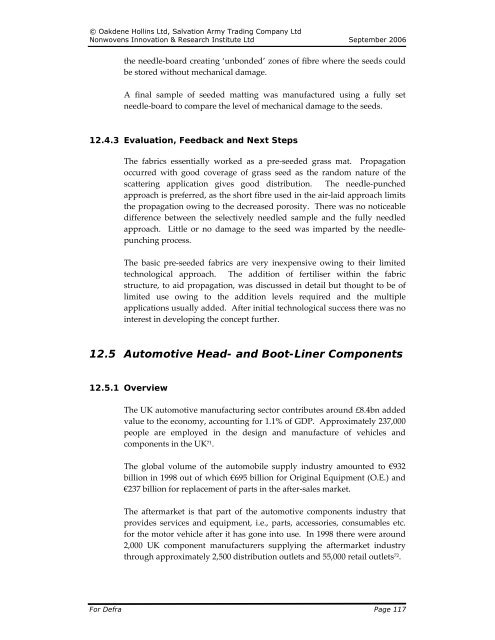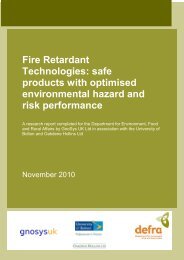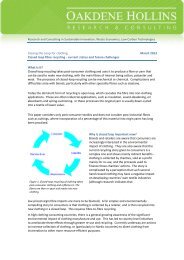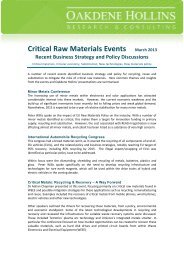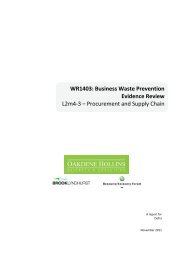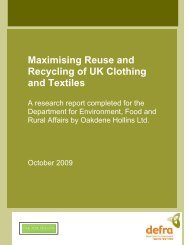Recycling of Low Grade Clothing Waste - Oakdene Hollins
Recycling of Low Grade Clothing Waste - Oakdene Hollins
Recycling of Low Grade Clothing Waste - Oakdene Hollins
You also want an ePaper? Increase the reach of your titles
YUMPU automatically turns print PDFs into web optimized ePapers that Google loves.
© <strong>Oakdene</strong> <strong>Hollins</strong> Ltd, Salvation Army Trading Company Ltd<br />
Nonwovens Innovation & Research Institute Ltd September 2006<br />
the needle‐board creating ‘unbonded’ zones <strong>of</strong> fibre where the seeds could<br />
be stored without mechanical damage.<br />
A final sample <strong>of</strong> seeded matting was manufactured using a fully set<br />
needle‐board to compare the level <strong>of</strong> mechanical damage to the seeds.<br />
12.4.3 Evaluation, Feedback and Next Steps<br />
The fabrics essentially worked as a pre‐seeded grass mat. Propagation<br />
occurred with good coverage <strong>of</strong> grass seed as the random nature <strong>of</strong> the<br />
scattering application gives good distribution. The needle‐punched<br />
approach is preferred, as the short fibre used in the air‐laid approach limits<br />
the propagation owing to the decreased porosity. There was no noticeable<br />
difference between the selectively needled sample and the fully needled<br />
approach. Little or no damage to the seed was imparted by the needlepunching<br />
process.<br />
The basic pre‐seeded fabrics are very inexpensive owing to their limited<br />
technological approach. The addition <strong>of</strong> fertiliser within the fabric<br />
structure, to aid propagation, was discussed in detail but thought to be <strong>of</strong><br />
limited use owing to the addition levels required and the multiple<br />
applications usually added. After initial technological success there was no<br />
interest in developing the concept further.<br />
12.5 Automotive Head- and Boot-Liner Components<br />
12.5.1 Overview<br />
The UK automotive manufacturing sector contributes around £8.4bn added<br />
value to the economy, accounting for 1.1% <strong>of</strong> GDP. Approximately 237,000<br />
people are employed in the design and manufacture <strong>of</strong> vehicles and<br />
components in the UK 71 .<br />
The global volume <strong>of</strong> the automobile supply industry amounted to €932<br />
billion in 1998 out <strong>of</strong> which €695 billion for Original Equipment (O.E.) and<br />
€237 billion for replacement <strong>of</strong> parts in the after‐sales market.<br />
The aftermarket is that part <strong>of</strong> the automotive components industry that<br />
provides services and equipment, i.e., parts, accessories, consumables etc.<br />
for the motor vehicle after it has gone into use. In 1998 there were around<br />
2,000 UK component manufacturers supplying the aftermarket industry<br />
through approximately 2,500 distribution outlets and 55,000 retail outlets 72 .<br />
For Defra Page 117


